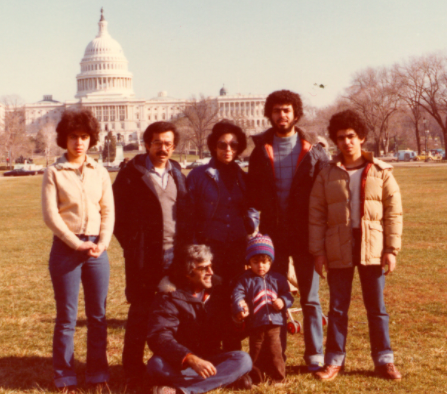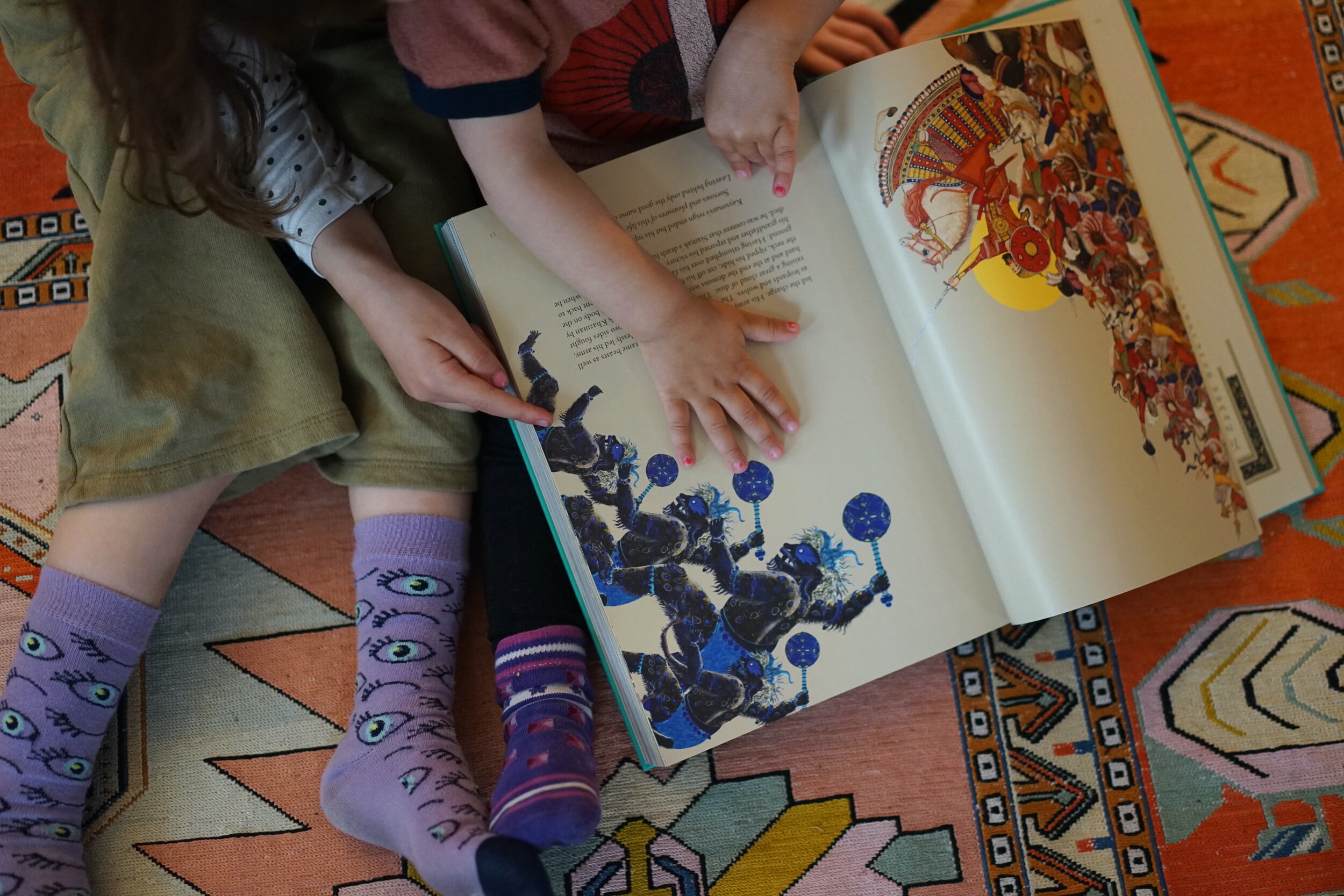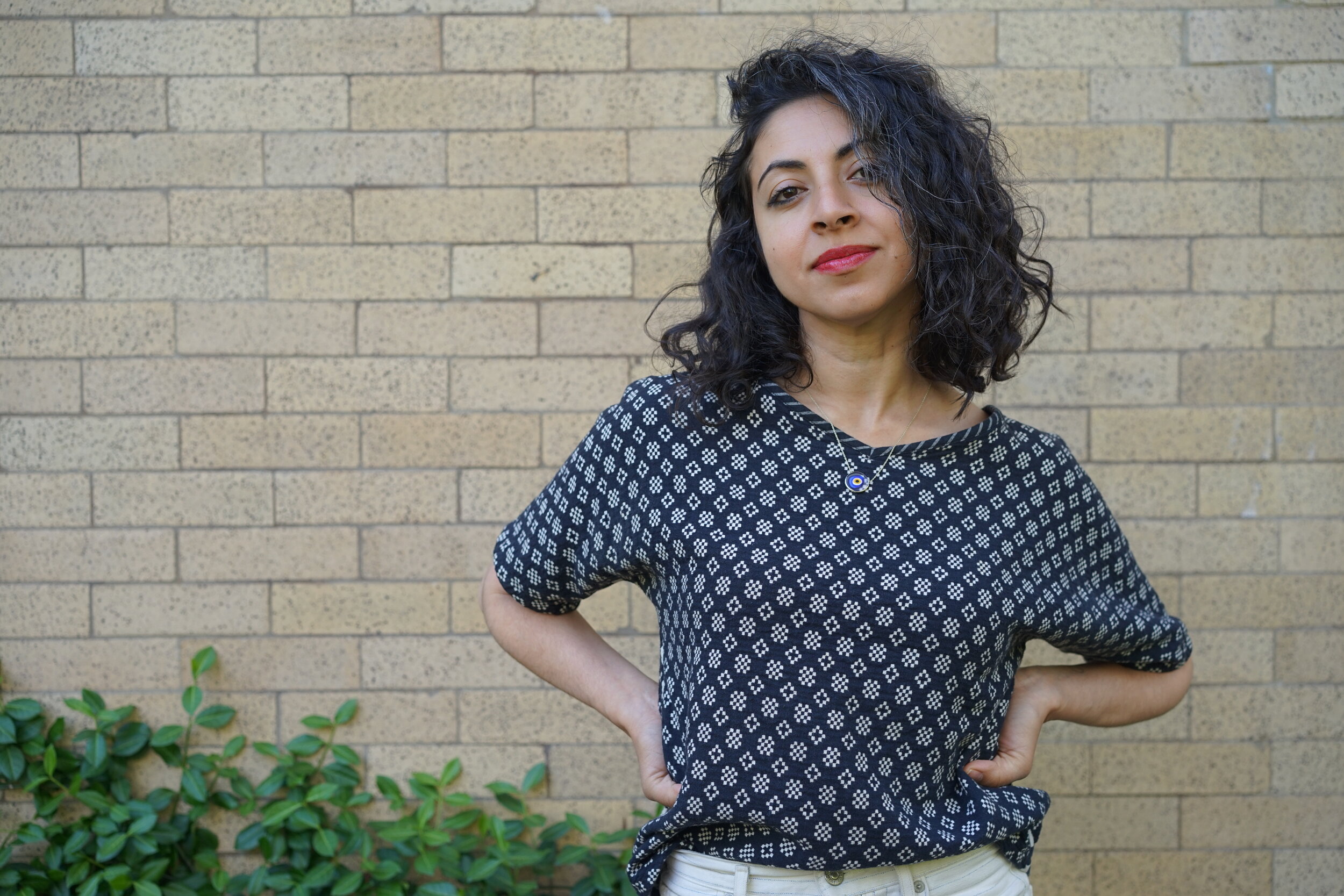The Persian kilim rug where I sit cross-legged with my toddler each morning is handwoven and colored with vegetable dyes in Shiraz, where my mother is from, where the dusty Zagros mountains tower above her childhood memories. Years ago, this kilim was folded thrice and smashed into a battered suitcase, lugged across three continents from plane to plane amid pouches of spice mix my great-aunt blends in her sweltering Bahraini kitchen.
The artifacts we keep tell a story.
My mother says the shapes depicted in the kilim’s pattern come to the weavers’ minds during the process, explaining why there’s a small cow’s outline on one side but not the other, the inspired asymmetry more beautiful to me than the calculated symmetry cherished in Western design.
Agar gov az panjareh didan, gov mizashtan to kilim, my mother would tell me, falling into a melodic lilt of storytelling. If there was a cow outside the window, they’d weave a cow into the tapestry. Anything they’d see would appear in the art, you see? I imagined a dozen weavers around a single loom, together creating a large scale masterpiece.
This rug, and the dozens like it that lend warmth to the cold tile and austere wood of our homes away from Home, is a talisman that steels me and my family against the American exaltation of the individual, the ruthless mentality that we wake each day to win on our own for our own. For this rug and my life’s refrain, it is the collective effort of individual ideas that renders the final piece gorgeous.
I believe in the collective.
On countless occasions, for as long as I can remember, my father reminded me that each of my actions affected the family. I feared a misstep because I couldn’t afford to represent my culture and my parents poorly; I knew my younger siblings looked to me as a model. But it was more than that. In my family, there was never ‘mine,’ but rather ‘ours.’ There were relatives and friends of relatives in and out of our house, sometimes living on the couch for months. I’d come home from school to find a new Khaleh in our small kitchen, washing parsley and cilantro for ghormeh sabzi. Without a community in the States, clear across the globe from his birthplace in the always-hot border town of Khorramshahr, the salty air of the Persian Gulf traded for the gray sky flurries of Pittsburgh, my father ensured we understood our responsibility to first look out for each other, to provide for others, to join in efforts to breed collective success.
I bring these beliefs every day to my work as an educator. I ask myself and teachers I support, how can we rethink classroom design to exalt community? How can we encourage students to share artifacts of their learning, emphasizing collective contributions above individual competition?
Growing up in a predominantly white school, I placed scant value on these textured family intricacies. I was the story you’ve heard over and over again, the heart-breaking one, where the girl tries hard to assimilate until she’s stripped completely of her history and reduced to the normative same. Straightened hair, curls smoking after each heated round-brush pull. Deep embarrassment in the back seat of a friend’s car, V-neck reeking of fried onions. Family who spoke too loud, grandparents who’d visit too long, overseas cousins who’d fax letters asking questions about Amrica. At each new introduction, a panicked moment as the new friend or teacher inevitably butchered my name: would I let it go? Sometimes I’d want to be called Nina. When we were asked in class to write childhood vignettes, I wanted to share that I learned the lyrics to Googoosh’s oonja kia kia before I formed memories in English. But I didn’t. I wrote about a trip to the zoo.
College undid me. I found all kinds of brown people with different experiences and suddenly, I wanted N-A-W-A-L, an Arabic name pronounced Persian style with a ‘v’, spelled out on a necklace. I took a Persian class to empower my writing abilities in a language I had grown up speaking. I was flushed with gratitude for the years my grandparents lived with us; how special that time was together, the satellite Persian television playing on like the soundtrack to our lives. When I visited family in Iran as a young adult, I learned that the same turmeric onions whose odor embarrassed me as a teen were the crucial base of every meal I adored. I learned that the ancient poet Hafez was among the long line of storytellers in my rich lineage, his 700-year-old tomb in the Musalla Gardens of Shiraz becoming my destination for meditation and reflection.
I realized asymmetry is perfection.
And yet, this experience of alarming assimilation then metamorphosis into love of one’s own culture is not necessarily what we want for our young people. How can we ensure that each child’s cultural capital and unique histories are woven into the fabric of our classrooms? How can we move past allowing for students to translanguage, but actually encourage it? How can we ensure children have the opportunity to learn about their history as part of the scope, not as an emergence they might accidentally stumble upon at some point later in their lives- maybe, if they’re lucky enough, fingers crossed? Our children are the curriculum, custodians of their unique, specific journeys. It is our job as leaders of learning to instill in them a supportive stance of amplifying each other’s strengths. We must teach about beauty in collectivity, uniqueness and asymmetry.
This morning, Eloisa Nasim, the youngest of our four kids, played on the kilim at my feet. Like each of her siblings, she carries names from both sides of her heritage: her father’s Puerto Rican side and my Middle Eastern, names I hope she owns each day of her existence with extreme pride. As she pretend-walked her doll across the rug, she pointed to a shape I had never noticed before. She cocked her head and smiled at me.
“Bird,” she cooed, more confident than I was about the depiction. Goodness, I hadn’t seen that. It could’ve been a bird- one that came to the weaver’s imagination back in Iran.
“Yes baby girl, dorost migi,” I told her. “It’s a parandeh.”
It reminded me of the ancient Persian story my uncle used to tell, about a flock of thirty birds in search of the famed Simorgh, a benevolent mythical creature roughly analogous to the Western Phoenix. But when the group of birds arrived at what they believed to be the Simorgh’s lakeside, what they saw was their collective reflection in the crystal water. You see, Si, in Farsi, means thirty; the Simorgh was not an all-powerful mystical being, but a manifestation of the awesome power inherent in the flock.
And that is exactly it. Our power resides in our collective strength. We are what we are seeking.
My family in Washington DC, 1980.
Ezzat and Eloisa page through the Shahnameh, translated ancient Persian tales. Looking for the Simorgh.
This blog post is part of the #31DaysIBPOC Blog Series, a month-long movement to feature the voices of indigenous and teachers of color as writers and scholars. Please CLICK HERE to read yesterday’s blog post by Edith Campbell (and be sure to check out the link at the end of each post to catch up on the rest of the blog series).
Nawal is an educator, literacy consultant and writer based out of Chicago, IL. Forever passionate about growing readers, writers and thinkers, Nawal worked as a classroom teacher, literacy coach and curriculum developer in Brooklyn and Chicago before launching NQC Literacy in 2014. She and her team support schools and districts by facilitating professional development and coaching around a holistic, balanced approach to literacy instruction: always looking through lenses of cultural-sustainability, inclusion and equity. She is the proud daughter of immigrants and her role as a mother to four multiethnic, multilingual kids shapes her approach as an educator. You can find Nawal in Chicago’s Logan Square neighborhood or on Twitter at @NQCLiteracy. She can be contacted directly at [email protected].





I’m speechless after reading this. The way you wove your words is as gorgeous as the kilim that warms the tile floor of your home.
I recall, during my second year of teaching, a child apologizing to me for writing dialogue in her personal narrative in Spanish since she knew it wasn’t a language I spoke. I told her there was no need for apology. She explained what it said and thus began my journey of encouraging kids to write in the languages they speak. Through the years (since I taught many bilingual kids), I learned that they had never had permission to do this before. That was heartbreaking.
Fast forward to this year. I was proofing something my daughter wrote and there was a part that didn’t feel authentic to me. I asked her, “What are the real words you’d say?” She used some Hebrew. I told her to write that down, but she resisted since she knew her teacher wouldn’t understand Hebrew. I insisted… and she did it. (And she didn’t get in trouble like she thought she would.)
There needs to be a way to help kids understand that they should bring themselves — their whole selves — into the classroom. No one should hide who they are. Thanks for this inspirational post that seeks to do that — and much more!
Lovely. Such beautiful words rich with meaning.
What a story and lessons for us inside your family, your history, your rug, your commitment to teaching and to STUDENTS. I’m going to copy this phrase on a post-it to keep me focused in these days of division: "manifestation of the awesome power inherent in the flock". Thank you, friend <3
Nawal, this piece is just gorgeous! It is written so beautifully and skillfully and really captures the essence of honoring the individual within community. These lines, in particular, spoke to me: "This rug, and the dozens like it that lend warmth to the cold tile and austere wood of our homes away from Home, is a talisman that steels me and my family against the American exaltation of the individual, the ruthless mentality that we wake each day to win on our own for our own. For this rug and my life’s refrain, it is the collective effort of individual ideas that renders the final piece gorgeous.
I believe in the collective."
I want to contribute to a society where we are working together for everyone’s benefit, not work on my own to win on my own- which is what I see and hear represented so often. Thanks for such a thought-provoking post.
One of the things I love about your writing– and there are other things, too– is how you blend the elements of setting and personal stories with reflections and concepts that matter and are provocative to readers. You lure me in with the story and then weave in important and provocative ideas about not only teaching and learning, but also about life.
This story both breaks my heart and fills it back up again. Love this line—“The artifacts we keep tell a story”—and the way you use your treasured kilim rug to share yours. Thank you.
Nawal, your fierce love of all things sacred, shines through in your writing. It is a pleasure to know and to love you!💕
Oh, Nawal, to hear your beautiful voice read this piece, and hear you pronounce the Persian names and words was a delight. Especially N-A-W-A-L Persian style! 🙂 Beautiful. I can’t believe I missed this post earlier. I’ve been missing your writing, so I came to see what you were up to. Thank you for your powerful storytelling. I loved the "collective" theme throughout, down to the Simorgh and the "awesome power inherent in the flock." Thank you for sharing. Now I’m going to check out the other #31DaysIBPOC posts I missed.